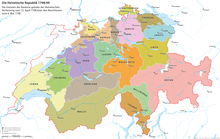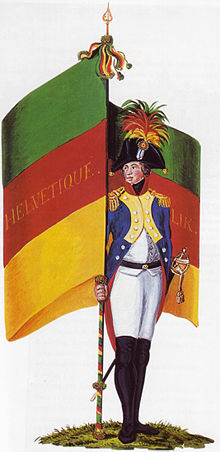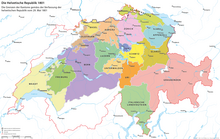Constitutions of the Helvetic Republic
The two constitutions of the Helvetic Republic date from April 12, 1798 and May 29, 1801. The second constitution is also known as the Malmaison constitution , as it was created at Malmaison Castle , Napoleon's country seat . The constitutions dictated by the occupying power of France followed the principles of enlightenment and human rights , but met with considerable resistance due to their centralized orientation in Switzerland , which as the old confederation was still a loose confederation of states . The Malmaison Constitution, which was intended as a compromise between centralism and federalism , failed to satisfy either side. It was replaced on February 19, 1803 by the mediation act .
prehistory
The revolutionary ideas of the French Revolution also met with great interest in Switzerland, first in the Duchy of Basel , where the certificate of freedom and the tree of freedom were erected on January 20, 1798 , then in the city republic of Geneva. There it came to an overthrow with French help and in 1796, as the first part of Switzerland, a democratic constitution was adopted. French troops also marched into the city of Basel because the Austrians with whom France was at war were standing there. Another part of the Principality of Basel, the Raurak Republic , was unceremoniously annexed by France in 1793. With the conquest of the rest of the Old Confederation by French troops, French law and French administration were now introduced into the country, which had previously been heavily dependent on France through long-term treaties.
A special episode took place in Lausanne : As in other Vaudois cities, on July 14, 1791, a "celebration" was held on the anniversary of the storming of the Bastille , understood by the authorities as a "declaration of war" and beaten down with 3,000 soldiers. Harsh punishments, the provocative behavior of the investigative commission, which operated under military protection, and disproportionate threats also disqualified the state power. Several pastors who took part in the celebration of joy or who had openly supported it, were removed from their offices, imprisoned or banished. The cousin of Frédéric-César de La Harpe, who would later become famous, was sentenced to death. His escape from execution led to the confiscation of all his property.
Reluctant forces, some of which welcomed new power relations and bourgeois-democratic freedom, and some favored the preservation and unification of the Old Confederation with the Unitarians, were cleverly played off by Napoleon by making small concessions to each other. He hoped for great advantages from a weak, divided Switzerland, as it could be better controlled from outside. The burden of war imposed on the Swiss in the form of higher taxes and the forced billeting of soldiers in Swiss houses led to an anti-French mood.
The first constitution
The first Swiss constitution was proclaimed on April 12, 1798 in the pro-French city of Aarau , which has been tested by the daily statutes, and is considered to be the founding date of the Helvetic Republic. The ten cantons of Aargau , Basel , Bern , Freiburg , Léman , Lucerne , Oberland , Schaffhausen , Solothurn and Zurich belonged to it. For executive was - similar to the French Directorate - the Helvetic Directorate selected but which consisted only of Republicans, so the lacked "grip" and assertiveness and therefore was considered from the outset as weak. In addition, the cantons of Central and Eastern Switzerland did not belong to the confederation, as they insisted on their sovereignty. The tree of freedom with the Tell hat was identified as the identification, and green-red-yellow were chosen as national colors.
The essential features of this constitution were largely adapted from the French and North American ideals of freedom. According to the principles of the Enlightenment and human rights , the state power committed itself to granting uniform civil rights, freedom of religion and conscience, freedom of the press and freedom of expression as well as the abolition of serfdom, feudal pressure and the privileges of birth. The prosecution of crimes and the control of government activities were also part of this constitution.
However, its author, the Basel lawyer and politician Peter Ochs , was unable to fully implement his ideas. He had intended to test this constitution first in his hometown and adapt it to needs before other cantons could voluntarily adopt it. The law, which Ochs had deliberately envisaged as a temporary measure, was denigrated by his opponents as a “hellish little ox-box” soon after it came into force, because the French added parts that had fatal consequences: the decisive flaw was the obligation of all cantons to immediately sign this constitution , because it was feared that the Swiss unified state would not find a majority on its own. In addition, they did not want to give enemy forces such as England and Austria an opportunity to influence the Helvetii, as had recently happened in Holland. France was able to exert its influence through the military victory and "did great damage to the new democratic order before it was constituted".
After the First Coalition War formally ended with the occupation of Swiss territory by the French and the peace of Campo Formio , the opposing forces in the country intensified. It was a matter of gaining supremacy in order to assert the desired state power. This required a constitution , which was presented in various drafts by the competing currents. Almost each of the cantons involved submitted their own draft. The differences included, on the one hand, different proposals for drawing boundaries between the cantons, and, on the other hand, diverging views on the autonomy of the cantons vis-à-vis the new state power as well as the powers of their citizens.
In addition, there were also geopolitical considerations that included strategic options that were important for France: Of the utmost importance was the ability to cross the Alps to northern Italy well, which would be guaranteed by securing the Simplon and St. Bernhard passes . Furthermore, a tripartite division of the country was considered, which roughly corresponded to the spheres of influence of France and Austria as well as the reformist central plateau.
According to Alfred Kölz , the constitutional text goes back to Napoleon himself: "After listening to various Swiss delegations and reviewing numerous Swiss constitutional drafts, including a federal project edited by the later restorer Karl Ludwig von Haller , [he] took the Swiss constitutional questions by hand."
According to Nold Halder , the development of the Aargau in particular was positively determined by Napoleon adding the upper Fricktal and the undivided canton of Baden to the Aargau. This increase is to be understood in particular as a counterweight to the oversized canton of Bern , which previously made up around a third of Switzerland and was thus weakened in the structure of the cantons.
The Fricktal was previously part of Habsburg territory; its residents protested about this change of power and continued to pay their taxes to the Breisgau administration, but with the peace of Lunéville this change became final. In return, a large part of the Valais - thirteen times the size of the Fricktal - was cut off in favor of France. The protest in the canton of Baden was very restrained. Only a few political leaders who still clung to the old government woke up from their “political slumber”, but the trend among the population was a sympathy “to be united with the good neighbors, the Aargauers”.
The second constitution
The original draft constitution is divided into sections. The first section begins with: «The Helvetic Republic forms one state. - Bern is the capital of Helvetia. - Its territory is divided into cantons. " Then the boundaries of the individual cantons are shown. The second section regulates "the common organization of the republic for the exercise of national sovereignty, and a cantonal organization". Further:
- The common organization includes the general higher police force,
- The armed force for the internal and external security of the republic,
- The political and diplomatic relations with foreign countries,
- The uniform administration of civil and embarrassing administration of justice,
- The provisions of that portion of the state taxes which each canton has to deliver.
- The national administration, salt, posts, mines, department stores and customs,
- The making and policing of the coins,
- The order and the police for the trade,
- The general and public educational institutions.
The cantons are responsible for collecting and distributing the basic taxes. The so-called "Zuchtpolizey", the national goods and the "Compensation of the clergy, the special educational institutions" are to be regulated cantonally.
In the third section it says: «The common organization of the republic is composed of a diet and a senate. ... The daily statute consists of the united representatives of all cantons, in the following proportions: Bern 9, Zurich 8, Waadtland 7, Aargau, Schafhausen, Graubündten and Appenzell 6 each, Lucerne, Glarus and Italian Vogteyen 5 each, Freyburg 4, Basel and Solothurn each 3 and Uri, Schwyz, Zug and Unterwalden 1 seat each, a total of 77 seats. " The session lasted five years and was convened by the Senate.
«The Senate consists of two governors and three and twenty councilors. No more than three members from one canton can sit in it. The Senate drafts the legislative proposals and submits them to the cantons for adoption. It decides all Maas rules and ordinances, which concern the administration and the general police. He declares war, makes peace and alliances, and confirms treaties. ... He elects the two Landammans from among his number. They remain in office for ten years; the simple senators five years. The Landammans preside alternately in the Senate, each for a year. The Landamman, who does not chair, is the deputy of the other in cases of illness or absence. The Senate appoints a small council from among its members. It consists of four members; the first Landamman is its chairman. This council is entrusted with the enforcement of the laws. "
Each of the four members of this council is entrusted with one of the following government subjects: internal affairs, administration of justice, finance and war. All officials of the general administration are subordinate to him and are appointed by him with the exception of the governors. While the chairman, who is also responsible for the exterior, received a salary of thirty thousand francs a year, his deputy and the four members of the small council received a salary of six thousand francs.
The fourth section shows the “Cantonal organization”. The governor, who is elected by the governor, has to execute the passed laws and supervise the higher police. The fifth section regulates the «eligibility conditions».
On April 30, 1801, in the audience given at Malmaison, a draft constitution came to light which, to be sure, did not quite correspond to the wishes of any party; According to this plan, which was published in Bern on May 29, a general assembly should follow in September for the approval of the draft drawn up by Bonaparte, in such a way that cantonal organizations would be drawn up beforehand by cantonal assemblies, these canton assemblies also the members of the general assembly should choose. "
resistance
Since the elections to the Diet resulted in a Unitarian majority, the Diet set up a constitutional commission, which began in September 1801 with a revision in the interests of the Unitarians. The Unitarian majority accepted this revision on October 24th, after which nine cantons withdrew from the Diet. With the help of the French army it came on 27./28. October 1801 for another coup . As stipulated in the Peace of Lunéville , the French troops withdrew from Switzerland in the summer of 1802. With this power vacuum and another coup d'état in June 1802, there was a plug-in war , in which the federalists of ten cantons rebelled against the Helvetic Republic. As an aftermath, the French moved back into Switzerland with their troops and dictated the mediation act. In June 1802, the Malmaison draft constitution led to the first nationwide referendum , which, however, can be judged as undemocratic: the vote was based on the veto principle. It was accepted with 72,000 votes in favor against 92,000 against, as the latter, with 167,000 eligible voters, was not enough for absolute rejection.
Further development
The Malmaison constitution, which was intended as a compromise, found no support on either side and was replaced by the Act of Mediation on February 19, 1803 . This act marks the beginning of mediation (1803–1813), which was replaced by a short restoration period and sealed after the Congress of Vienna in 1815 with the formation of Switzerland within largely today's borders.
Important concerns of the Malmaison constitution could not be implemented, but it must be understood as a breach of the Ancien Régime . It was not until 1848, a generation later, that their supporters were found for the central points:
- The liberation of the peasants and the abolition of tithes
- System of direct taxes
- Standardization of currency, measure and weight as the basis of a common economic area
literature
- Holger Böning : Revolution in Switzerland , Lang, Frankfurt am Main 1985, ISBN 3-8204-8486-8 .
- Gérard Benz: La Constitution de la Malmaison: publication inédite de son mémoire - 1963. Sierre 2012, ISBN 978-2-88924-061-6 .
- Alfred Kölz : Modern Swiss constitutional history. Its basic lines from the end of the Old Confederation to 1848 . Stämpfli + Cie. AG, Bern 1992, especially pp. 124-142.
- Andreas Heusler : Swiss constitutional history. Frobenius, Basel 1920, p. 307ff.
- Nold Halder : History of the Canton of Aargau , vol. 1, publishing house for the newer Aargauer Zeitung, Aarau, 1953, pp. 3–10
Web links
- Draft of the Helvetic State Constitution. Bern 1801.
- The struggle for a new division of the Helvetic Republic
- Constitution of the Helvetic Republic of April 12, 1798
- Draft for a constitution of the Helvetic Republic of May 29, 1801 (Malmaison constitution)
- Draft for a constitution of the Helvetic Republic of October 24, 1801
- Draft for a state constitution for the Helvetic Republic of February 27, 1802
- Constitution of Helvetia of July 2, 1802 (Constitution of the Notable)
Individual evidence
- ^ Holger Böning : Revolution in der Schweiz , Lang, Frankfurt am Main 1985, p. 55.
- ↑ Holger Böning: Revolution in der Schweiz , Lang, Frankfurt am Main 1985, p. 202.
- ^ Paul de Vallière: Loyalty and honor: history of the Swiss in foreign service , German edition Verlag F. Zahn, Neuchâtel 1912, p. 643f.
- ^ A b c Holger Böning: Revolution in Switzerland , Lang, Frankfurt am Main 1985, pp. 108-121.
- ^ The French Revolution , Chronology: Sextidi, 26. Ventôse, year 222 of the Republic
- ↑ Franz Schnabel : An Introduction to the History of the Latest Time , Geneva [o. J.], p. 20
- ^ Alfred Kölz : Modern Swiss Constitutional History. Its basic lines from the end of the Old Confederation to 1848 . Stämpfli + Cie. AG, Bern 1992, p. 138 f.
- ↑ a b Halder : History of the Canton of Aargau , Bd. 1
- ^ Draft of the Helvetic State Constitution
- ↑ a b Andreas Kley: Constitutional history of the modern age. UK, USA, France, Germany and Switzerland . Stämpfli, Bern 2013, ISBN 978-3-7272-8682-7 , pp. 266f.




